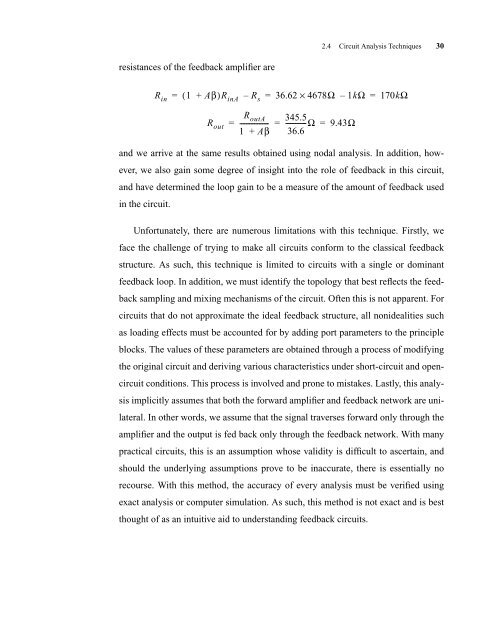CMOS Optical Preamplifier Design Using Graphical Circuit Analysis
CMOS Optical Preamplifier Design Using Graphical Circuit Analysis
CMOS Optical Preamplifier Design Using Graphical Circuit Analysis
Create successful ePaper yourself
Turn your PDF publications into a flip-book with our unique Google optimized e-Paper software.
esistances of the feedback amplifier are<br />
2.4 <strong>Circuit</strong> <strong>Analysis</strong> Techniques 30<br />
and we arrive at the same results obtained using nodal analysis. In addition, how-<br />
ever, we also gain some degree of insight into the role of feedback in this circuit,<br />
and have determined the loop gain to be a measure of the amount of feedback used<br />
in the circuit.<br />
Rin = ( 1 + Aβ)RinA<br />
– Rs = 36.62 × 4678Ω – 1kΩ = 170kΩ<br />
R out<br />
R outA<br />
345.5<br />
= ----------------- = ------------Ω =<br />
9.43Ω<br />
1 + Aβ 36.6<br />
Unfortunately, there are numerous limitations with this technique. Firstly, we<br />
face the challenge of trying to make all circuits conform to the classical feedback<br />
structure. As such, this technique is limited to circuits with a single or dominant<br />
feedback loop. In addition, we must identify the topology that best reflects the feed-<br />
back sampling and mixing mechanisms of the circuit. Often this is not apparent. For<br />
circuits that do not approximate the ideal feedback structure, all nonidealities such<br />
as loading effects must be accounted for by adding port parameters to the principle<br />
blocks. The values of these parameters are obtained through a process of modifying<br />
the original circuit and deriving various characteristics under short-circuit and open-<br />
circuit conditions. This process is involved and prone to mistakes. Lastly, this analy-<br />
sis implicitly assumes that both the forward amplifier and feedback network are uni-<br />
lateral. In other words, we assume that the signal traverses forward only through the<br />
amplifier and the output is fed back only through the feedback network. With many<br />
practical circuits, this is an assumption whose validity is difficult to ascertain, and<br />
should the underlying assumptions prove to be inaccurate, there is essentially no<br />
recourse. With this method, the accuracy of every analysis must be verified using<br />
exact analysis or computer simulation. As such, this method is not exact and is best<br />
thought of as an intuitive aid to understanding feedback circuits.














